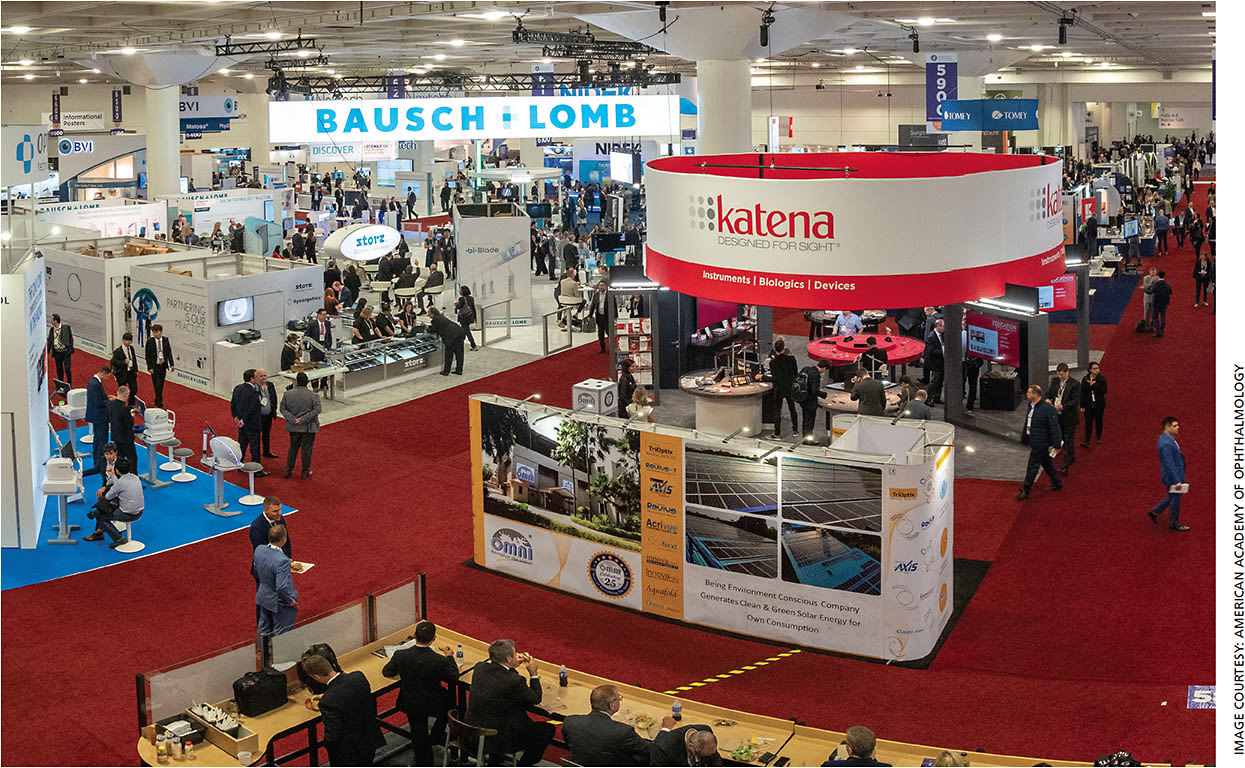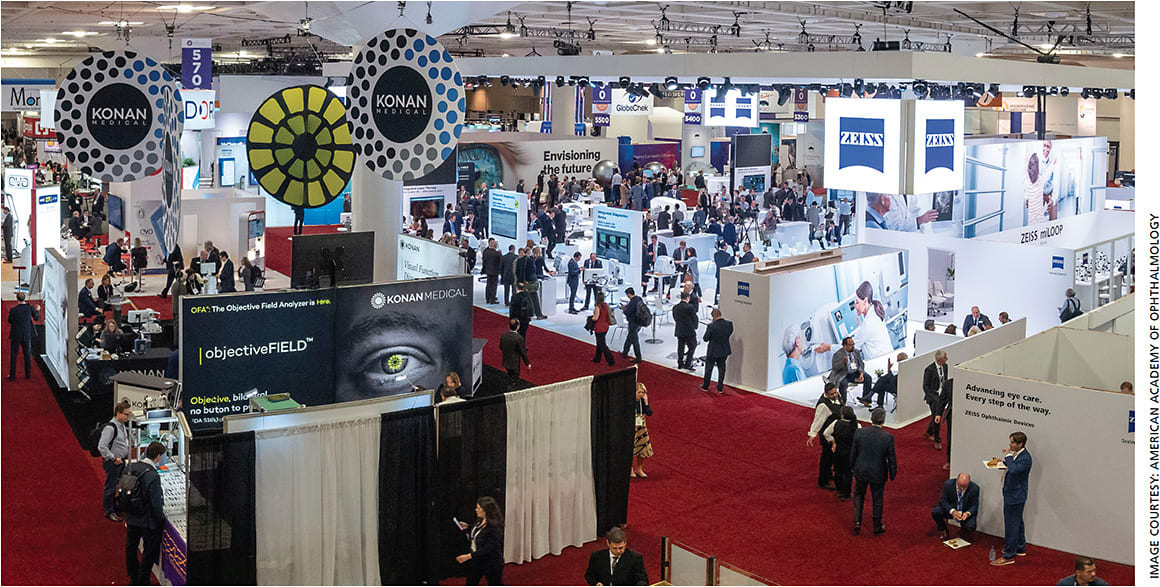With dozens of booths, three show floors and thousands of visitors, there was more to see at this October’s AAO annual meeting than could easily fit into the show’s three days. Just in case you didn’t get the chance to fully explore the exhibit hall in San Francisco or did not attend the meeting this year, members of our editorial board and other OM contributors offered their highlights from the 2019 show.

DIAGNOSTIC AND IMAGING TECHNOLOGY
Avellino’s AvaGen genetic test is designed to identify the risk of developing keratoconus and the presence of corneal dystrophies. Mitchell Jackson, MD, says it is a “first of its kind DNA genetic test.” The AvaGen can help detect early cases of keratoconus for those with borderline topography/tomography, explains Dr. Jackson.
Canon’s Xephilio OCT-A1 was displayed at AAO after launching this fall. The Xephilio OCT-A1 is an OCT system indicated for the in-vivo imaging and measurement of the retina, retinal nerve fiber layer and optic disc. It features the ability to retain scan position and scan protocol for each patient between exams, eliminating the need for manual adjustment.
Ellex’s Eye Prime ultrasound device, which received FDA approval this spring, uses Six-Ringed Annular Array Technology to transmit and receive ultrasound waves from six concentric transducers, each of which can be individually pulsed. This is designed to allow the Eye Prime to refocus and enhance images in 1-mm increments.
Zeiss’ new OCT device, the Cirrus 6000, allows OCT/OCTA scans with 12 mm x 12 mm OCTA and B-scan depth up to 2.9 mm; it also offers new workflow patterns designed to increase efficiency. The Cirrus 6000 impressed Cynthia Matossian, MD, for being “significantly faster at capturing images with very high accuracy.” Also, Zeiss’ TRENION 3D HD is a high-definition, stereoscopic video device that allows surgeons to share three-dimensional images that could normally only be seen through a surgical microscope. Dr. Rostov calls the TRENION “a great innovation in imaging that includes the ability to visualize surgery and have live OCT to enable better and more complete visualization for both anterior and posterior segment surgery.”
SURGERY AND TREATMENT
Alcon’s AcrySof IQ PanOptix was approved by the FDA earlier this year. It is the first trifocal IOL cleared for use in the United States. The PanOptix is “working better than anyone expected,” says Daniel Durrie, MD. Kendall Donaldson, MD, also calls the trifocal one of her standouts of the show. Regarding PanOptix, Audrey R. Talley Rostov, MD, says that it is “exciting to have another IOL that has the hope of providing patients with a broader range of vision.” Also, Alcon’s NGENUITY 3D visualization system with DATAFUSION can give surgeons a 3D visualization of the back of the eye during surgery. Dr. Matossian says she was glad to see “heads-up surgical platforms” like the NGENUITY 3D continue to grow in popularity at AAO. In addition, the company’s iLUX Patient Care Kits can be offered by physicians to iLUX patients; the kits include samples from Alcon’s Systane family of products to help continue treatment of dry eye symptoms at home as well as a patient brochure. Laura Periman, MD, says she appreciates these “integrated post-procedure and patient education programs, which help clinicians and patients alike.”
Orca Surgical’s Epi Clear device allows the use of the Epi-Bowman’s keratectomy procedure for laser refractive surgery. Marguerite McDonald, MD, calls Epi-Bowman’s keratectomy “a modern approach to PRK with fast return of vision and virtually no pain.”

MEDICATIONS
Bausch + Lomb’s Lotemax SM (loteprednol etabonate gel) 0.38% is designed to treat inflammation and pain following eye surgery. Lotemax SM can benefit patients by allowing for better penetration while using less concentration of the active drug, says Dr. Matossian. The medication achieves this penetration through the use of “sub-micron technology.”
Novartis’ Beovu is a treatment for wet AMD approved by the FDA in October; the medication is a brolucizumab-dbll injection. Clinical trials have found Beovu to be the first FDA-approved anti-VEGF to offer greater fluid resolution vs. aflibercept and the ability to maintain eligible wet AMD patients on a three-month dosing interval after a three-month loading phase with no loss in efficiency, Novartis reports.
Sun Pharma’s Cequa (cyclosporine ophthalmic solution) 0.09% is used to increase tear production in dry eye patients. Cequa’s NCELL technology is meant to enhance penetration by using nanomicelles composed of polymers to encapsulate the cyclosporine. For Dr. Rostov, “it is great to have another anti-inflammatory option for patients with dry eye disease. We know the efficacy of cyclosporine is well established, and the opportunity for a potentially faster-acting form of the drug is exciting to offer patients with dry eye disease.”
TECHNOLOGY
EyeMD EMR 2.0 includes a fresh user interface and enhanced usability. This new version of EyeMD features FOG computing technology, which merges the benefits of client/server and browser-based cloud systems. FOG technology allows practices to choose whatever technology architecture best addresses their individual needs while allowing them to pivot to an alternative solution as business needs change.
Google’s Naama Hammel, MD, was among the speakers at the “Artificial Intelligence and New Technologies for the Ophthalmologist” presentation. Dr. Hammel described a deep learning algorithm that can analyze fundus photographs and predict whether patients with intermediate AMD will progress to neovascular AMD within one year as well as a model that uses color fundus photographs to predict diabetic macular edema. She also discussed an algorithm that could determine the gender of a patient with 90% accuracy simply by examining the retina. “I was blown away when the Google AI could tell male and female gender from retina fundus photos,” says Uday Devgan, MD. “I have been looking at retinas for 25 years and I cannot tell male vs. female.”
Lisa Nijm, MD, was also impressed by what she saw of AI at AAO. “It has the potential to revolutionize the way we practice ophthalmology,” she says, “from coming up with better dry eye algorithms to identifying patients who would benefit most from premium lens technology.”
Johnson & Johnson Vision revealed the CHiME Manage “smart inventory” management system cabinet at AAO. This product is designed to automate the inventory process. Dr. Matossian says she believes the system will “improve speed and efficiency while minimizing errors and work force costs.” OM








